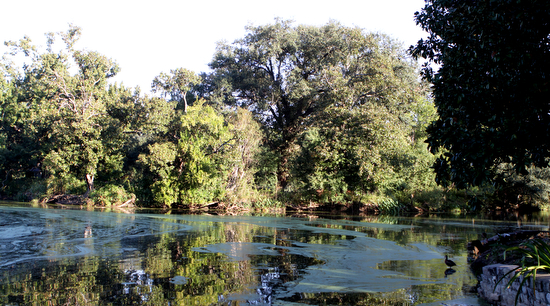
A lone waterbird stands at the edge of the lagoon at Audubon Park earlier this week. (Sabree Hill, UptownMessenger.com)
Article by Colby Wilson, for UptownMessenger.com
Nearly six months after the startling disappearance of a large population of birds from Audubon Park’s Bird Island, the rookery has yet to recover, and local birdwatchers are still feeling its loss.
“Our park patrons have a lot of personal and emotional investments in Bird Island,” said Sarah Burnette of the Audubon Institute. “The primary negative impact isn’t necessarily on the wildlife. It’s on the people.”
The large rookery in the center of the park’s lagoon drew a growing crowd of spectators until the birds mysteriously took off in early April, leaving behind their nests, including their eggs. Throughout the summer, theories for their abandonment included relocating for better food, disease, violent thunderstorms, and visiting film crews.
Lee Schoen, the curator of birds at Audubon Zoo, visited Bird Island last week. “It looks really abandoned,” Schoen observed.
To date, no single cause has been identified. Avian experts are still stumped, including Don Norman, a visiting biologist from Seattle who specializes in colonial waterbirds. “We don’t know whether the birds permanently left, but the colony failed,” Norman said, “and it did not re-nest.”
David White, a professor of biological sciences at Loyola University, thinks it’s still too early to assign blame, he said.
“There are just too many possibilities for why the birds disappeared,” White said. “Nature doesn’t always do something we don’t like simply because we did something bad.”
“Bottom line is, we don’t know why the birds disappeared,” Burnette said. “We walked the island on foot. Tried to figure out if it was predation, but couldn’t really definitively say one way or the other.”
In a park that has long served as a refuge from city life for New Orleanians, the loss has been keenly felt among local bird lovers. Visitors miss hearing the once familiar sound of birdcalls echoing across the park, Norman said. “Even if you don’t know the difference between a squirrel and a duck, you can hear it,” he said. “It’s just amazing.”
In the past, Bird Island’s population included great egrets, snowy egrets, cattle egrets, tri-colored herons, black-crowned night herons, anhingas, yellow-crowned night herons, and double-crested cormorants. The island’s inhabitants were wild, so they were not banded, tagged or identified, Burnette said, and no one knows for sure whether they will return. “We will have to wait until next spring, or late winter, to see whether the nesting birds will be returning,” said Peter Yaukey, a professor of geography at the University of New Orleans.
In the meantime, birdwatchers will continue to visit the urban oasis. Despite the abandonment of the island, “There are other interesting birds to be found in Audubon Park,” Yaukey said, “rookery or not.”
“The wildlife will persevere, whether it’s in the park or somewhere else,” Burnette said, but “the people who enjoy the park really miss seeing the birds.”
Colby Wilson is a senior majoring in journalism at Loyola University New Orleans and can be reached at colbyjamrock@gmail.com. This article appears on UptownMessenger.com in partnership with the Beginning Reporting class taught by Loyola Maroon advisor Michael Giusti.
Two possibilities I heard talked about:
1. The drought – No rain meant that their droppings etc. were not washed away and made the island just too dirty for the birds.
2. Rats – there is a large rat population in Audubon Park, and they may have been able to swim over to the island and prey on eggs and chicks.
I have no idea if either idea is correct, but I thought I would mention them.
A few months be fore the abandonment, I noticed a nutria swimming over to the island early one morning. I called it to the attention of the Audubon Institute by e-mail and received a reply saying they were aware of the problem and were acting on it. I wonder if there is any connection?
In my research I learned that there were no signs of predation on the Island.
The drought is an interesting factor. Contrarily, many people proposed that it was the thunderstorms last spring that may have disturbed the rookery.
I’d like to see more responses to both those factors.
This is really heartbreaking. Every time I walk by I think about the missing birds. If they don’t return, I hope there are plans to restock the island with new birds somehow.
BTW — the park needs a more visible and accessible online presence. I’ve long wondered about how to make an online donation, what it would cost to sponsor a larger project (like adding a bench — the park needs ALOT more benches), etc. Also to report issues I notice, or ideas for improvements. I love the park and use it almost every day.
The park is a government monopoly that takes in a lot of our tax dollars, so you’re probably already contributing to the park involuntarily.
While there aren’t any birds on the island there are a number of herons and egrets (both white and gray and an occasional pink) in other trees in the same area. Not sure why the island is the only focus of the story.
There will be a story on WWL-TV tonight regarding this subject.
the whistling ducks have come backin the last few days. and earlier this summer, there were herons nesting in the oaks in the corner of the park bordered by st charles and exposition.
there were almost no gypsy moth caterpillars this spring. they usually are all over the park in april. i have no idea if there is a connection to the egrets leaving the rookery, but it’s worth mentioning.